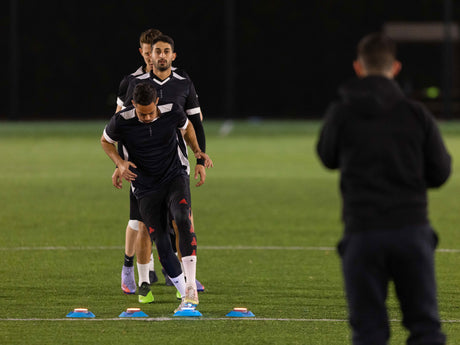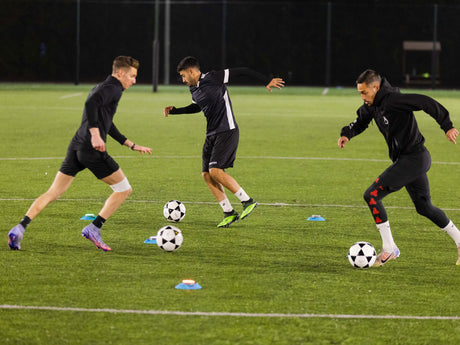Soccer is a game of endurance. Players who can last 90 minutes (or more) while maintaining a high level of agility, flexibility, strength, and quickness will often have a competitive advantage.
Endurance during a match comes down to your players’ stamina. This is the ability to sustain physical and mental effort for a prolonged period. More than just running around in the field without fatiguing easily, stamina in soccer is the key ingredient to giving your ‘all’ throughout the game. It also takes stamina and endurance to keep up with highly agile opponents.
Much like developing speed through soccer speed drills, stamina can be developed over time using soccer endurance training drills, these drills can be further enhanced by using the Blazepod pods and app, find out which Blazepod training kit fits you best.
How to Build Your Stamina for Soccer
How long your players endure in a match is a reflection of their overall fitness level. The reason why most players get tired so quickly on game day is failure to push themselves hard enough during soccer stamina training exercises. Often, players will show up in the training facility, kick around some dead balls, and then relax. This is preparing to fail.
Proper soccer stamina training needs to push the players out of their comfort zone. There needs to be that aspect of ‘suffering,’ by pushing your heart, lungs, and muscles to go beyond a point that you thought you wouldn’t go. This develops perseverance, which is necessary if your players have to remain in control of the game.
Another important aspect when developing a speed and endurance training program is to ensure that it’s customized specifically for soccer. It’s necessary for your players to learn how to run longer in soccer. But keep in mind that this is not a linear game: it involves a lot of sprinting, acceleration, deceleration, changes in directions, and recovery jogging.
As the coach, you want to consider soccer speed endurance training drills that resemble the type of work your players will be putting in during a match. Here are the top drills you can add to your soccer endurance training sessions.
How to Develop Speed Endurance- 6 Soccer Stamina Drills
1. Shuttle Runs
Shuttle runs are among other popular speed endurance soccer drills that coaches use to train speed, acceleration, and anaerobic fitness. An effective drill to add to your soccer fitness drills and workouts, shuttle runs are generally simple and can be done anywhere- in the gym, on pavements, and even on grass.
Set Up and Execution
- Set up 3 cones in a line leaving a distance of 20 and 30 yards between them.
- At the coach’s cue, the player sprints from cone 1 to cone 2, touches the cone, and then sprints back to 1.
- The player then dashes from cone 1 to cone 3, touches the cone, and sprints back to 1 again. That’s one rep.
- Perform 5 repetitions totaling 500 yards.
- Let the players rest for 5 minutes before making another set.
- Time your players and encourage them to try and beat their previous record.
To make these endurance running workouts more effective, the players should change direction snappily and get back to full speed as quickly as possible. You can also get creative by adding a soccer ball to the mix. Pass the ball to the players and have them pass it back when they get to a certain cone.
2. Stop and Go Soccer Endurance Drills
The reason why you want to add this workout to your soccer fitness training program is that it simulates exactly what your players do during the game. This exercise involves a mix of jogging and sprinting for a given period (30-45 minutes). It helps in adapting the body to the constant running that’s required when playing soccer. The other major benefit with this training is injury prevention because it works lower body and core muscles.
Set Up and Execution
- This activity involves running around the pitch while alternating between jogs and sprints.
- Let the players warm up to flex their muscles before beginning this drill.
- To begin the exercise, the players start by sprinting at 100% speed from the corner flag to the halfway line.
- From the halfway line, the player decelerates to 50% effort up to the other corner flag.
- Along the goal line, the player slows down to a jog for recovery.
- At the end of the goal line, the player sprints at full speed up to the halfway line.
- Next, they run at 50% effort for the last half before slowing down to a jog at the second goal line.
The players repeat these patterns for 30-45 minutes to simulate one half of a soccer game. If you can’t access the entire field, the players can go around the available half twice to make one rep. When recovering, encourage the players to slow down to a comfortable jog that allows them to catch their breath. They should not stop or walk.
3. Stairs Workout for Stamina and Speed
Did you know that running stairs is another excellent way of teaching your players how to develop speed endurance? Stair running is a high-intensity plyometric activity that forces the muscles to exert 100% power in short intervals. The nature of these exercises causes the muscles, tendons, and ligaments to flex and contract rapidly, and this builds a lot of stamina.
Stair running can also be added to your soccer conditioning drills because it increases the heart rate besides training the lungs to take in more oxygen. This, in turn, boosts the player’s VO2 max (maximal oxygen uptake).
Set Up and Execution
- The players should begin by warming up thoroughly. Light jogging for 10-15 minutes and performing high knees, grapevine, and strides are recommendable ways of preparing the muscles and getting the blood flowing.
- After warming up, the player starts running up the flight of stairs to accumulate 30 seconds and then walks down the stairs to recover. That’s one rep.
- Perform 5 reps to make one set and rest for two minutes before completing another set.
As your players get used to these soccer endurance training drills, show them how to engage the entire body to make it an all-around workout. They should maintain a good climbing posture by holding their heads straight with their line of vision locked at the top of the stairs. Also, they should move up by pushing their thighs (not extending their legs) and landing on the balls of their feet.
4. Speed Hill Sprints
There’s no doubt that hill sprints require a great deal of mental and physical toughness. That’s why you need this workout activity when developing an effective speed and endurance training program.
Sprinting on a hill is the kind of workout activity that combines strength and speed to give you stronger and faster players. It’s akin to lifting weights while running. This forces your heart and lungs to reach far greater intensities than you usually would.
This drill will be pretty tough for players who are used to exercising on flat terrains. But after a few weeks of training, it will become easier for them to endure sprinting and jogging throughout the match. Besides developing endurance, hill sprints also boost speed and explosiveness- 2 of the most critical assets for a soccer player.
Set Up and Execution
- You’ll need a hill that takes 3 minutes or more to run up.
- Like other soccer endurance training drills, the players need to have warmed up before trying this exercise.
- The players start by running 5 uphill reps of 1-minute each with a jog-down recovery interval after each rep.
- Let them rest for 3 minutes after the first 5 reps.
- Next, they do five 45-sec uphill runs with jog-down recovery followed by a 3-minute rest.
- Then, they perform three 30-second uphill sprints jogging down after each rep to recover. Rest for another 3 minutes.
- Lastly, they run the entire length of the hill (3 minutes), accelerating the last 30 seconds.
5. Dribble and Run
Next up is one of the easiest soccer endurance drills with a ball that you can use to develop endurance among beginners. This activity is fairly simple because it’s meant for starters. But you can combine it with other soccer agility drills to make it more challenging as your players’ experience increases.
Set Up and Execution
- The player starts by performing some light warm up activities to loosen up.
- Place a cone along the touchline and another cone directly opposite the first one on the other touchline.
- To start, the player dribbles the ball as fast as possible from the first cone heading towards the second cone.
- Halfway, the player leaves the ball and sprints to the opposite touchline, where he/she goes around the cone.
- Next, the player runs towards the ball and dribbles it back to the starting position.
- The player takes a 1-minute break before making another rep.
- Make 6 reps per session.
One way of making this drill more fun and challenging is to have the players compete. You can also place obstacles along the way, for instance, hurdles or cones that the players have to dribble the ball around or jump to intensify the workout.
6. Planks
The core musculature and strength are essential attributes for a soccer player. A vital role of core workouts is to train the muscles around the abdomen, pelvis, lower back, and hips. These are crucial muscle groups as they improve balance and stability. Working these muscles also contribute significantly to developing stamina.
Planks are some of the best workouts for developing your core strength. This is because they challenge all the muscles to work together. Of course, it’s important that your players combine planks with other exercises that target the core, including supermans, bridges, flutter kicks, and Russian twists, for quicker results.
Set Up and Execution
- Setting up for planks is pretty simple. First, start by lying belly-side-down on a mat flexing your feet so that the toes are on the mat. Your feet should be less than hip-width apart.
- iNext, with your arms placed on the mat right beside your shoulders, take a deep breath and push your body up by strengthening your arms and lifting your knees and thighs. Keep your elbow locked to ensure stability.
- To reap the full benefits of these exercises, your body needs to be in a straight line with the belly pressed against the spine. Your head also needs to be in a neutral position so that the chin is neither pointing out nor bent towards your chest.
- When done correctly, you should feel the core muscles and glutes engaged and working together.
- When starting, encourage your players to hold this position for 1 minute followed by a 30-second rest before going for another rep.
- Let them complete a total of at least 5 minutes in every training session.
Planks are generally easy to pull off and can be easily incorporated in other soccer workout drills. They are incredibly easy to modify too depending on what you want your players to work on. As your players get used to standard planks, they can try other variations, such as foreman planks, side planks, standard planks with arm and leg extensions, and walking planks.
Blazepod is a pro-level flash light training system designed to help your players and clients of all levels to reach fitness excellence. With its ruggedized LED light-up pucks that link to the Blazepod App via your phone and Bluetooth connectivity, Blazepod is regarded by most trainers and coaches as a fun and incredibly effective tool for developing agility, quickness, reflex, and coordination.
The pods are both waterproof and smash-proof and have an operating battery time of up to 1 day with standard activity. This allows you to take them anywhere from the living room to the gym and even to the park- whatever works for your training exercises.
Check out our soccer page, devoted entirely for soccer coaches, you can find all sorts of guides covering a plethora of topics ranging from speed testing to decision making exercises.








